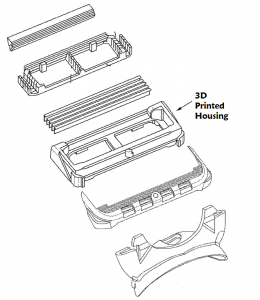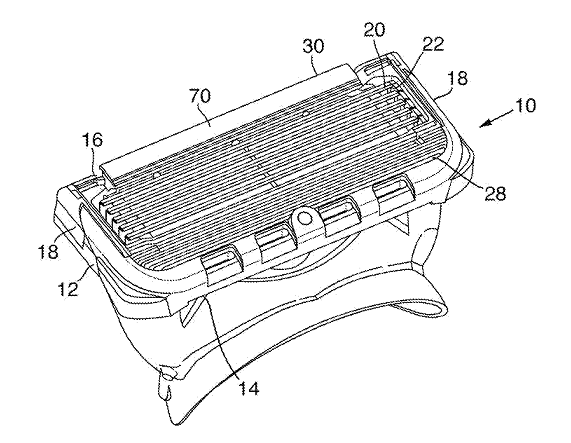 There are literally dozens of new patents filed on a weekly basis that have something to do with 3D printing. However, one company, that most people probably wouldn’t expect to file patents related to 3D printing, would be The Gillette Company. You know, the company that makes just about every type of razor out there.
There are literally dozens of new patents filed on a weekly basis that have something to do with 3D printing. However, one company, that most people probably wouldn’t expect to file patents related to 3D printing, would be The Gillette Company. You know, the company that makes just about every type of razor out there.
According to a patent that has recently been published (US20140033538 A1), Gillette has come up with a method of forming a functional razor cartridge using 3d printing. The razor cartridge is the part of a handheld razor that clips into the handle.
Currently several companies use rapid prototyping; mainly additive manufacturing (3d printing) to develop different handles for razors, as well as the razor cartridges. They utilize this technology to test out different product ideas. However, up until now, these prototypes have not been capable of actually being tested in real life situations. This is because either the materials used could simply not hold up, or there have been inaccuracies in the dimensions of the prototypes.
The patent filing goes on to explain this in detail:
“For example, materials used previously in the formation of model razor cartridges were unable to withstand exposure to hot water without changing in property. As a result, thus far razor cartridges made by rapid prototyping have been useful only for assessing the look, dimensions and interaction of different components of a razor and have not been functional for shaving.”
Up until this point in time, most functional testing of razor parts have had to rely on using traditional mold tools. This allows companies to put the suitable materials that could hold up to shaving, into the mold. Molding, however, takes weeks or even months to finish, and can cost a ton of money. Then once a defect, flaw or desired dimension needs to be fixed or modified, it becomes very difficult and expensive to do.
This is where 3D printing comes into play. The patent filed is for the 3D printing of razor cartridges, using materials that can hold up to shaving. This would be done using liquid ultra-violet curable photopolymer resin and an ultra-violent laser to build the cartridges one layer at a time.
The patent explains this in more detail:
“To form a housing with sufficient strength and durability for application in a functional razor, a filler is suspended in the UV-curable resin. In the present invention, the filler is nano-particles of aluminum oxide that are suspended in the UV-curable resin. However, other known fillers may alternatively be used; for example, crystalline silica or a ceramic filler may be used. UV-curable resin with aluminum oxide suspended therein has been found to have sufficient strength and durability to withstand pressure that may be applied to the housing during a normal shaving process. Furthermore, material as described herein that is formed of a filler suspended in UV-curable resin can be subjected to much higher temperatures compared with UV-curable resin without filler such that a housing formed of a filled UV-curable resin can withstand being held under varying degrees of hot water.”
The company believes that this can greatly improve efficiency and lower costs. They believe that this technology will allow them to easily and affordably make small changes to the razor cartridge, to make it perform better.
While this patent is only for the 3D printing of the razor cartridge housing, other parts of the cartridge may also be printed using this technology.
It appears as though Gillette is using this patent filing to improve their efficiency in the manufacturing, and prototyping of their razors. However, it isn’t out of the realm of possibility that this technology could also be used to create custom razors that fit to their clients face perfectly.
Discuss what you think this patent will ultimately achieve, in the Gillette Razor thread on 3Dprintboard.
Subscribe to Our Email Newsletter
Stay up-to-date on all the latest news from the 3D printing industry and receive information and offers from third party vendors.
You May Also Like
Human Remains Could Be Identified with the Help of Forensic 3D Printing
I’m still in awe at what additive technologies can accomplish, from creating alternative meats, automotive parts, shoe insoles, and surgical models, to giving faces to the lost. That is to...
3D Printing News Briefs, May 17, 2023: Stress-Resistant Alloy, 3D Printed Trophies, & More
In today’s 3D Printing News Briefs, we’re starting off with a little research, as materials scientists developed a 3D printing process that produces an extremely stress-resistant alloy. Moving on to...
On the Ground with COBOD Construction 3D Printing at Ohio State
This winter, The Ohio State University’s Center for Design and Manufacturing Excellence (CDME), which is one of the country’s largest additive research groups, received a COBOD BOD2 3D construction printer...
3D Printing Webinar & Event Roundup: April 2, 2023
You can breathe easy this week, because it will be much less hectic than last week, at least in terms of 3D printing webinars and events to attend! There will...

































